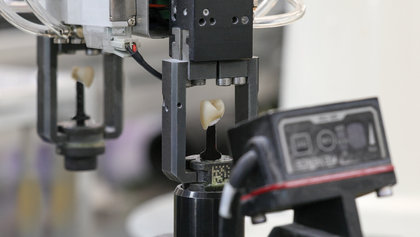2201 Dupont Dr., Irvine, CA 92612
© 2025 Glidewell. All rights reserved.
800-854-7256 USA
Glidewell partners with Beckhoff to use flexible, scalable automation to customize its prosthetic tooth factory.
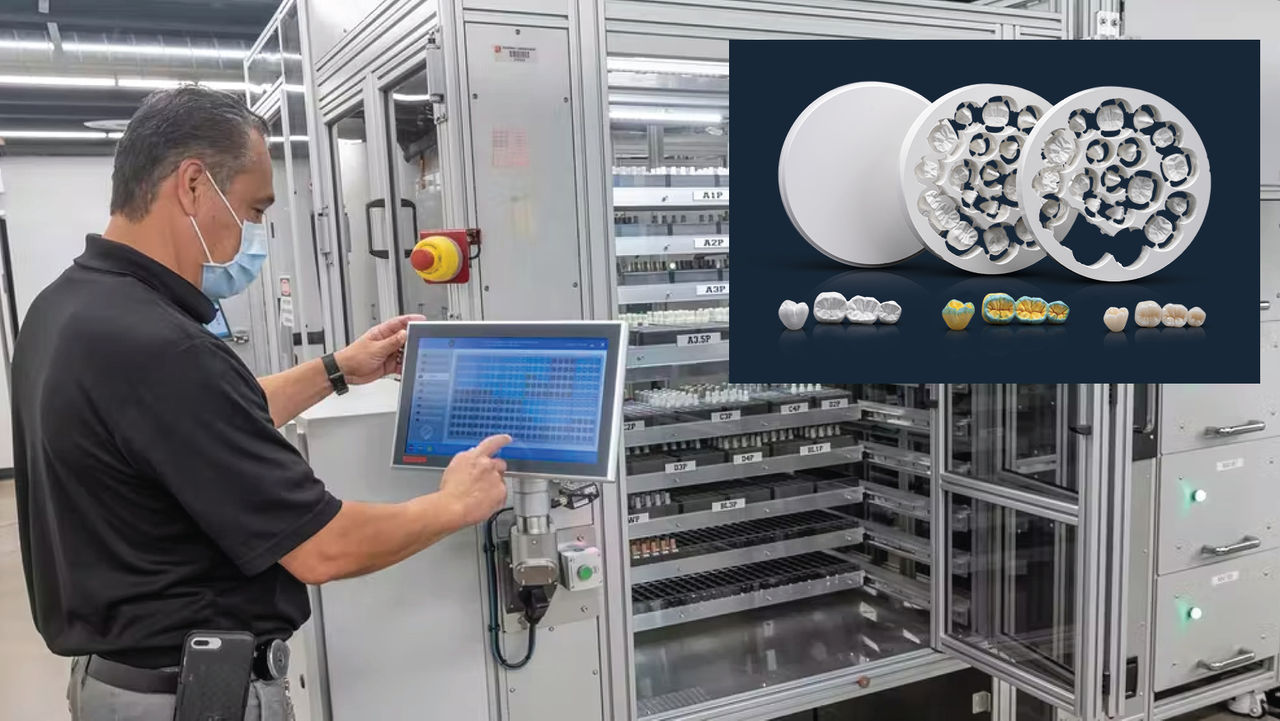
In restorative dentistry, every product is Lot Size 1. For Glidewell, producing tens of thousands of patient-specific devices such as crowns, bridges or dentures each week requires intensive engineering efforts. Glidewell’s investments in automation and cloud-connected systems have culminated in what is known as Intelligent Manufacturing (IM), allowing the company to maintain its industry-leading market share.
“We do business with some 60,000 dentists each year, or nearly 50% of all practicing dentists in the U.S.,” said David Leeson, vice president of Engineering at Glidewell. Flexible automation provides a decisive advantage in an industry that still relies heavily on skilled artisans using time-consuming manual processes.
Dentists either mail physical impressions to Glidewell or upload 3D digital impression images to the company’s proprietary material requirements planning (MRP) digital platform, CloudPoint®, built on the Amazon Web Services (AWS) cloud. A proprietary AI technology then generates a custom prosthetic design to match the impression and turns the CAD file of each patient-specific restoration into a unique project.
Glidewell IM assigns a case with the prescribed characteristics, such as tooth size, shade and thickness, and selects a zirconia milling blank of suitable size, shape and color. A robot transfers the zirconia blank to a milling tower for detailed anatomical shaping, after which the restoration undergoes glazing for a more natural surface appearance. Barcode scanners track the case throughout the process, and if an operator removes the case for any reason, a vision application follows the technician and case.
“To make this a closed-loop process, optical scanners generate a 3D geometry of the finished product, and an algorithm compares it to the design file. The dental restoration must be within 50 μm to pass quality inspection — and most often, it’s within 20 μm,” said Kunal Patil, automation manager at Glidewell. “Performing just the glazing by hand could create variances of up to 150 μm. PC-based automation helps us achieve much higher precision.”
However, it was not always this way. Jim Glidewell founded the company in his apartment in 1970 using traditional, hand-fabrication techniques. As his number of dentist customers grew, so too did his need for additional labor and supporting services, giving rise over the years to a highly diverse and self-sufficient manufacturing chain.
Today the Irvine, California-based company produces everything from restorative materials to final restorations and other medical devices and employs more than 5,200 Glidewell professionals around the globe. Following dentistry’s CAD revolution in the early 2000s, Glidewell evolved quickly to its current highly automated, cloud-based production.
“Now we are creating heavily connected systems and leveraging data from the more than 10 million individual patient designs we store in the cloud,” Leeson adds. “Our vision is to keep extending up and down the value chain to improve our current products and create new ones.” This vision is most fully realized in the Glidewell IM workflow, despite technological and environmental challenges.
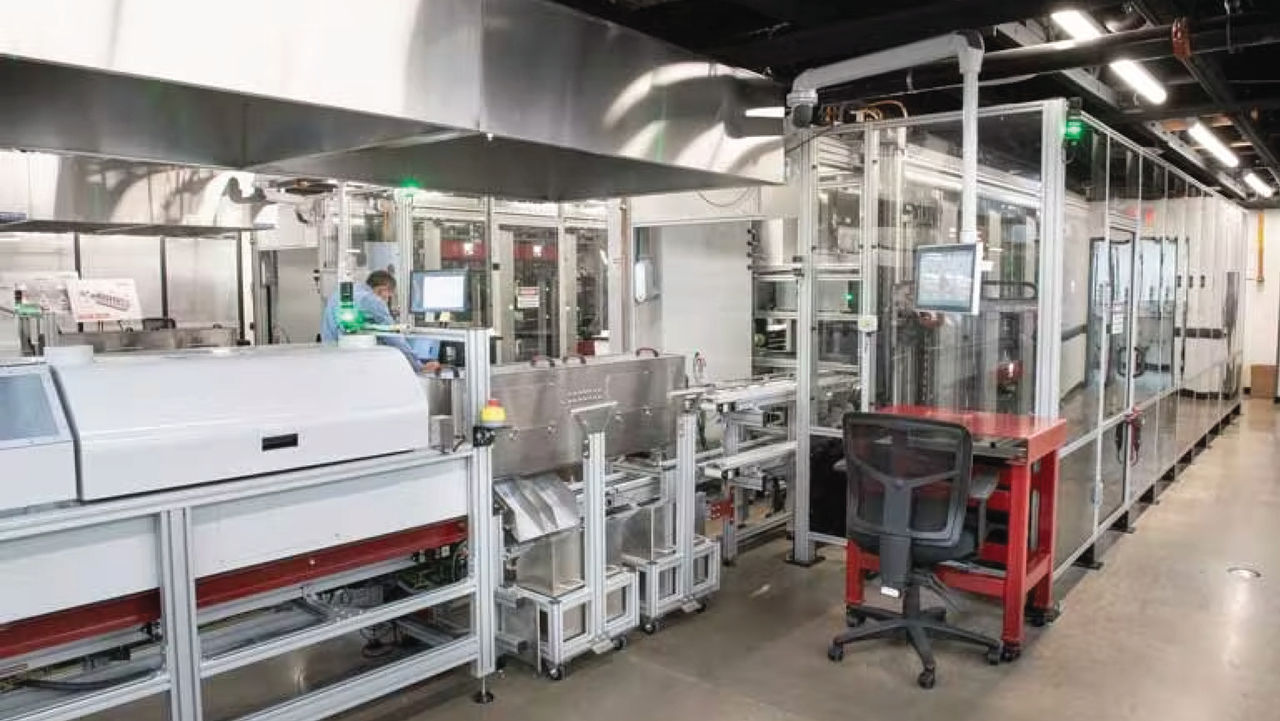
Glidewell implemented two complete monolithic crown manufacturing lines with 20 mills each in its laboratory for BruxZir® Zirconia restorations.
To reduce delivery times and waste in manufacturing, the BruxZir machines require extreme speed and data acquisition capabilities. This requires robust control and connectivity technologies. “The machines constantly update the cloud database when a case moves from one production step to another, monitoring the time between steps and sending these insights to our Case View Management dashboard,” Leeson said. “Since our products are produced on-demand, we always have a customer waiting for anything we make, and we cannot replace products from stock like other companies. If an order sits for too long, the system automatically adds it back to the queue. We don’t try to track the product down; we just make another.”
From the beginning of the Glidewell IM implementation, the engineering team needed the automation technologies to be flexible, scalable and industrial hardened. The machine controllers and motion components would need to adapt to constantly changing recipes. Also, Glidewell soon needed to scale up from a single milling tower of four mills to five milling towers in a system — and eventually, to a second complete system of five towers, totaling 40 mills. Finally, the components needed to withstand significant amounts of abrasive zirconia dust.
As Glidewell began to implement the milling tower in 2018, the engineering team soon realized that its standard machine control technologies were not up to the task. “We struggled with many issues involving synchronization between robots and multiple controllers, debugging and real-time communication, while using a familiar controller,” Patil says.
Glidewell worked closely with the local Beckhoff Automation team, including regional sales engineer Charles Usher and applications engineers John Helfrich and Lauren de Rosset. Within a week, the team proved out the concept using PC-based control systems. Within a month, a newly operational mill met all of Glidewell’s production requirements.
Glidewell IM leverages multiple Industrial PC and TwinCAT 3 automation software solutions from Beckhoff. The C6015 ultra-compact IPC is an AWS-certified device and serves as the IoT gateway, delivering programs from the cloud. The C6930 Control Cabinet IPC is the main system controller, communicating with multiple robots, vision systems, field devices and machine controllers at the milling towers.
Each milling tower relies on a CX5140 Embedded PC to run 4-axis motion on four mills — i.e., 16 axes per controller — using TwinCAT NC I. Working in concert, the PC-based controllers provide optimal connectivity, processing power and scalability to automate 20 mills, with 80 axes of motion, in one standard system.
Beckhoff also installed Windows-based cybersecurity tools and custom application programming interfaces for cloud communication directly on the machine controllers. Beyond the application-specific considerations, Glidewell IM needed to meet California IoT regulations that took effect in 2020. “In the past, we avoided putting antivirus software on real-time systems as it harmed performance. Isolating machines on the network was still a risk, and it complicated connectivity,” Leeson explains. “With Beckhoff IPCs, we can run approved antivirus software in the Windows environment. This solution meets all cybersecurity demands without affecting performance, which is impressive.”
The IM milling system also sends valuable production data to the AWS cloud for analytics, troubleshooting and predictive maintenance using Beckhoff solutions. TwinCAT IoT and the C6015 IPC — which interfaces with AWS IoT Greengrass, the open-source edge runtime and cloud service — enable easier discovery of data insights to boost machine performance.
“Our analytics constantly monitor the average load on the motors, communicating from the milling towers to the cloud. As a result, we see if motors are performing well or if tools are beginning to wear down.” These insights, combined with a modular system design, enable operators to quickly swap one mill for another that has been refurbished with new router bits.
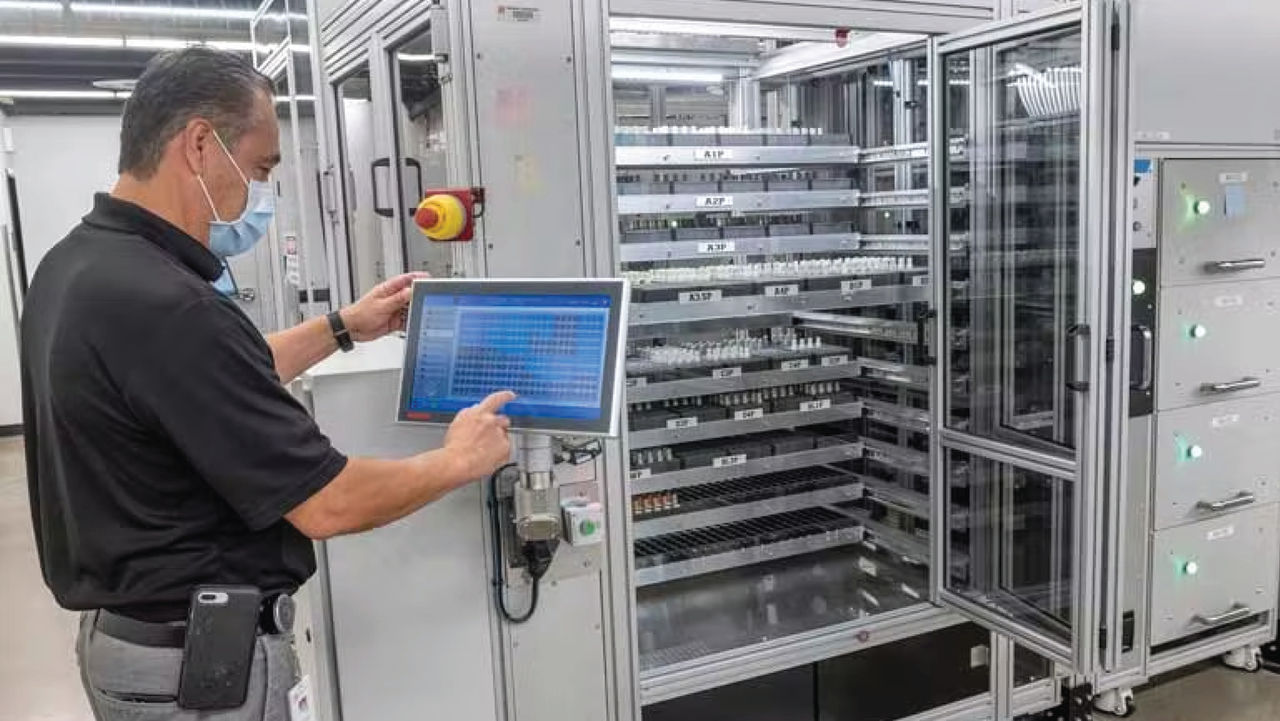
The Glidewell IM application uses Beckhoff Control Panels for greater visualization of milling processes.
While TwinCAT and PC-based control enable cloud connectivity, the EtherCAT industrial Ethernet system makes high-performance production of the dental implants possible. EtherCAT offers real-time communication rates for the plant floor, up to 65,535 nodes on one network and TwinSAFE functional safety.
“With so many concurrent processes, we do not want every mill to stop if someone presses an E-stop for a particular mill. TwinSAFE allows us to stop specific mills and safety zones, and we can create that logic entirely within one project,” Patil says. Glidewell used a wide range of TwinSAFE and EtherCAT I/O modules from Beckhoff in DIN rail and machine-mounted form factors.
The functional principle of EtherCAT — processing on the fly, distributed clocks, free selection of topology, etc. — makes it an ideal motion bus. AX5000 Servo Drives from Beckhoff power the pick-and-place robots that feed new cases to the milling towers. In the mills, AM8000 series servomotors and EL7211 servomotor terminals offer compact form factors and the flexibility to execute varying NC programs.
The EtherCAT I/O modules further reduce machine footprint with One-Cable Technology, which combines power and feedback. Constant directional changes put substantial stress on the servomotors, but the AM8000 components offer robust operation with reliable precision.
“If the motors deviated even slightly, our final product would not match the design file, or the material could chip and show defects even from minor vibrations,” Patil says. “Maintaining the required high precision is no problem for EtherCAT and the Beckhoff servomotors. We run the motors at a cycle time of 250 microseconds, which we could actually cut in half if needed.”
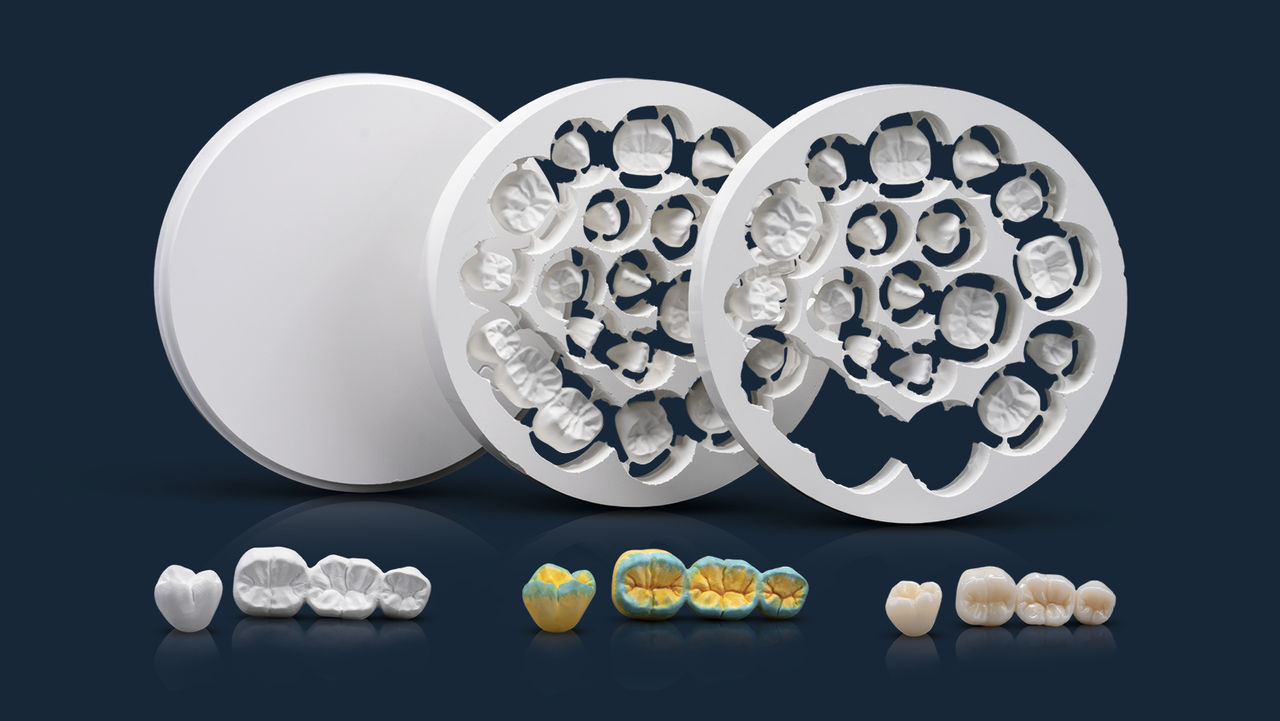
Every product that comes out of Glidewell IM’s workflow is Lot Size 1: Blanks are selected based on patient-specific characteristics and milled according to custom projects.
Each mill completes a case in roughly 10 minutes, maintaining round-the-clock production. Following the success of the first line with PC Control and EtherCAT, Glidewell completed another line of 20 mills. The company is now implementing a third full line, reaching a total of 60 mills. Glidewell was able to scale production without sacrificing performance or quality. Data from each mill is sent to the cloud every 2 seconds, which allows the company to eliminate downtime through predictive maintenance and continue to act on valuable production data to enhance products.
PC-based automation cut the number of components required, according to Leeson: “Our previous controllers could only handle a single mill each, where the Beckhoff controllers operate four mills each. In addition, to achieve the same data acquisition and cloud connectivity, the previous controllers would have required a separate PC.”
Glidewell continues to evaluate new Beckhoff technologies, including Gigabit communication with EtherCAT G and TwinCAT HMI software, to further enhance their solutions. “Glidewell and Beckhoff have similar histories, starting with a single owner, and charting rapid growth through a passion for innovation,” Patil says. “So, we don’t see Beckhoff as our vendor. We see them as our partner.”
This article was contributed by Beckhoff Automation.
Send blog-related questions and suggestions to hello@glidewell.com.
